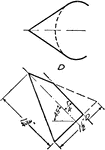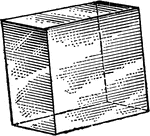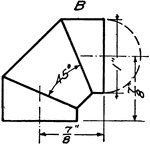
Prism Showing Volume
Illustration of a prism used to demonstrate that the volume of any prism is equal to the product of…

Volume of Prismatoid
Diagram used to prove the theorem: "The volume of a prismatoid is equal to the product of one-sixth…

4 Congruent Rectangular Prisms
Illustration of 4 congruent rectangular prisms placed in the shape of a square. They are arranged to…

Equal Prisms
Illustration showing two prisms are equal if the three faces which include a trihedral angle of the…

Oblique Prism Truncated Into 3 Sections
Illustration of an oblique prism constructed by the combination of three truncated prisms.

Two Equal Prisms
Diagram used to prove the theorem: "Two prisms are equal when the three faces about a trihedral of one…

Development Exercise of Hexagonal Pyramid
A sample exercise problem in completing the top part of the hexagonal pyramid and to create a development,…

Development Exercise of Oblique Hexagonal Pyramid
A sample exercise problem to complete the top part and create a stretched out image of the oblique hexagonal…

Development Exercise of Pentagonal Pyramid
A pentagonal pyramid problem exercise to complete the top view of the image, and development, or rolled…

Development Exercise of Pentagonal Pyramid
The problem exercise in completing the top view and creating the development, or rolled out, image of…

Isometric of Oblique Pentagonal Pyramid
Illustration of the isometric of an oblique pentagonal pyramid.

Triangular Pyramid For Volume
Illustration of triangular pyramid used to show that the volume is the limit of the sum of the volumes…

Rainbow Diagram
A bow of prismatic colors formed from the reflection and refraction of the sun and water. In the diagram,…

Volume Of A Rectangular Solid
Illustration of a 5 in. by 3 in. by 4 in. rectangular solid with each cube in the solid representing…
Similar Rectangular Solids
Illustration of a 1 in. by 2 in. by 1 in. rectangular solid that is similar to a 2 in. by 4 in. by 2…

Reflecting Prism
"Fresnel next conceived the admirable improvement of employing the principle of "total" or internal…

Prismatic Reflector
"Cross-section of prismatic reflector, showing how light rays are refracted and dispersed." —Croft…

Refraction of Complimentary Colors
"The prism will deflect the red and orange, and form a reddish colored image at n. The violet, indigo,…

Rhombohedron
"Science has succeeded in classifying the thousands of known crystals in six systems, to each of which…

Scapolite
This figure shows a combination of forms sometimes observed on the silicate Scapolite, with the unit…

Prism of the second order
"This is a form consisting of six rectangular vertical faces, each of which intersects two of the horizontal…

Second Right Square Prism
"Science has succeeded in classifying the thousands of known crystals in six systems, to each of which…

Six-sided Pyramid
"Science has succeeded in classifying the thousands of known crystals in six systems, to each of which…

Solar Spectrum
"Solar Spectrum.—If a ray, proceeding from the sun, be admitted into a darkened chamber, through…

Oblique View Of Rectangular Solid
Illustration of an oblique view of a rectangular solid/prism at 30°.

Oblique View Of Rectangular Solid
Illustration of an oblique view of a rectangular solid/prism at 45°.

Oblique View Of Rectangular Solid
Illustration of an oblique view of a rectangular solid/prism at 60°.

Combination of Geometric Solids
Illustration of model created by combining non regular geometric solids.

Spectrometer
"An instrument used chiefly to measure the angular deviation of light rays in passing through a prism,…

Spectroscope
"C. Collimator; P, center of group of prisms; T, telescope; s, slit through which the ray of light enters,…

Direct Vision Spectroscope
"...an instrument which gives a spectrum when the source of the light is in a straight line with the…
Color Spectrum
"A prism is used to disperse ordinary light, and slits are cut in paper S to only allow yellow and blue…

Isometric of Stairs
Illustration of stairs; 3-dimensional view of 4 steps. The staircase can be created by combining/stacking…

Staurolite
"Orthohombic. Habit prismatic, showing usually a combination of prism with large angle, brachypinacoid,…

Stevensons Revolving Light
"In 1835 Mr. Stevenson, in a report to the Northern Lighthouse Board, proposed to add fixed reflecting…

Straight Prisms
"Condensing Straight Prisms.—These, either by reflexion or refraction or both, cause a ray fr…

Swans Designs
"Professor Swan's Designs.—Among several ingenious arrangements and new forms of agents proposed by…

Development Exercise of Cylinder using Three Piece Elbow
The exercise problem of creating a three piece elbow development or rolled out image of the cylinder…

Tourmaline
This crystal of Tourmaline exhibits hemimorphism in the direction of the vertical axis. Its forms are…

Projections of Triangular Prism With Hole
Projections of a triangular prism or block with a square hole.

Development Exercise of Triangular Pyramid
Exercise problem to develop, or rolled out, image of the triangular pyramid by creating an equal length…

Volume of Triangular Pyramid
Diagram used to prove the theorem: "The volume of a triangular pyramid is equal to one third of a triangular…

Twin Prism
"Condensing Twin Prism Light.—Part of the Lamiash light in the Firth of Clyde. Its action will…

Union of a Pyramid and a Prism of Different Orders
This illustration shows the union of a pyramid and a prism of different orders.

Union of a Pyramid and a Prism of the Same Order
This illustration shows the union of a pyramid and a prism of the same order.

Vesuvianite
"Tetragonal. Prismatic in habit. Often vertically striated. Common forms are prisms of first and second…

Vesuvianite
This form shows a very complex combination of thirteen tetragonal forms occuring on the mineral Vesuvianite:…

Yttrium Niobate
Also known as Fergusonite, this crystal shows the basal pinacoid, (c); the unit pyramid, (s); and the…

Zincite
"A crystal of zincite with a prism terminated by a pyramid above a basal pinacoid below." — Ford,…

Zircon
"Zircon, a mineral composed of of zirconium silicate, sometimes used as a gem-stone... THe mineral crystallizes…








